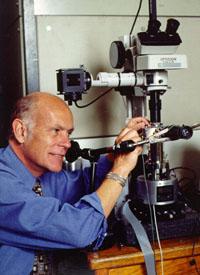
Richard E. Smalley received his B.S. from the University of Michigan in 1965 andhis Ph.D. from Princeton in 1973. In his postdoctoral period at the University of Chicago, he pioneered what has become one of the most powerful techniques in chemical physics: supersonic beam laser spectroscopy.
Dr. Smalley was named to the Gene and Norman Hackerman Chair in Chemistry at Rice University in 1982, after having been at Rice for only six years. He was one of the founders of the Rice Quantum Institute in 1979, and served as the Chairman from 1986 to 1996. Since 1990, he has also been a Professor in the Department of Physics, and was appointed Director of the new Center for Nanoscale Science and Technology at Rice in 1996. In 1990, he was elected to the National Academy of Sciences, and in 1991 to the American Academy of Arts and Sciences.
Along with the Ben Franklin Medal, Dr. Smalley has been the recipient of numerous other prizes, including the 1996 Nobel Prize in Chemistry.
Dr. Smalley is widely known for the discovery and characterization of C60 (Buckminsterfullerene), a soccerball-shaped molecule which, together with other fullerenes such as C70, now constitutes the third elemental form of carbon (after graphite and diamond). His group has also been the first to generate fullerenes with metals trapped on the inside. His current research is focused on the production of continuous carbon fibers which are essentially giant single-fullerene molecules. Just a few nanometers in width, but many centimeters in length, these fullerene fibers are expected to be the strongest fibers ever made, 100 times stronger than steel.
Information as of 1996

